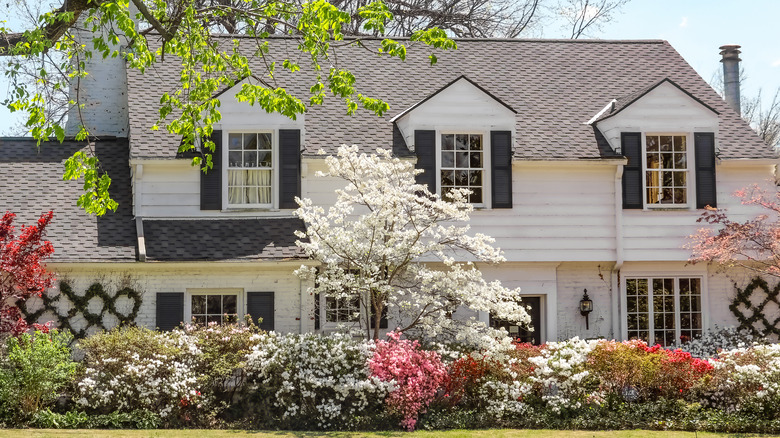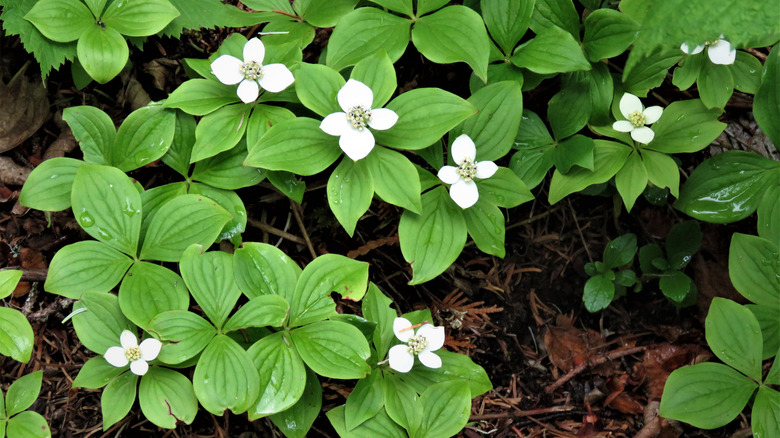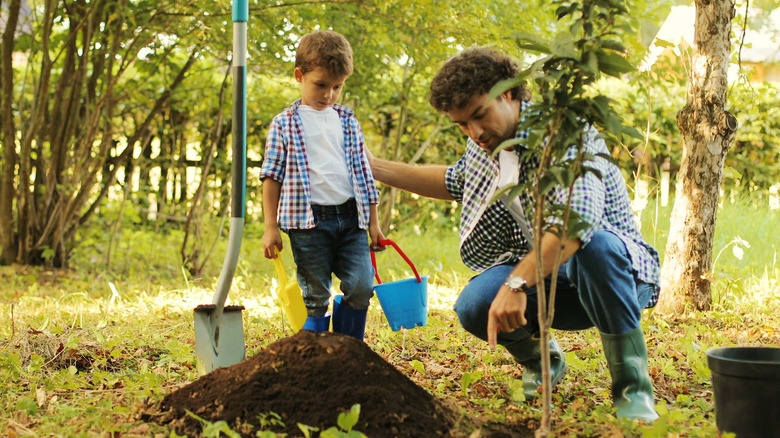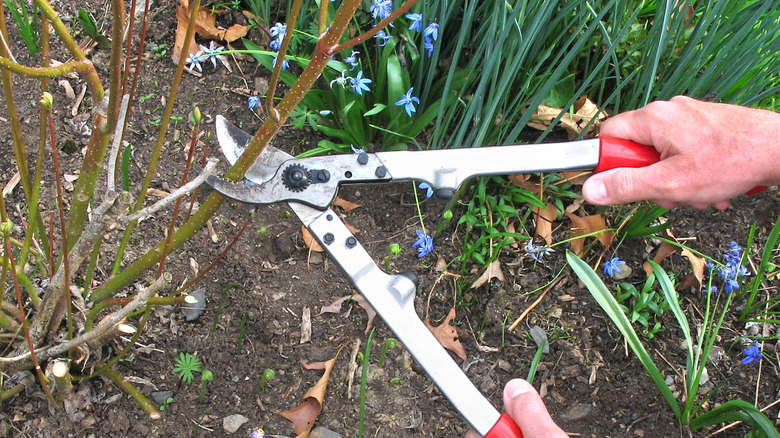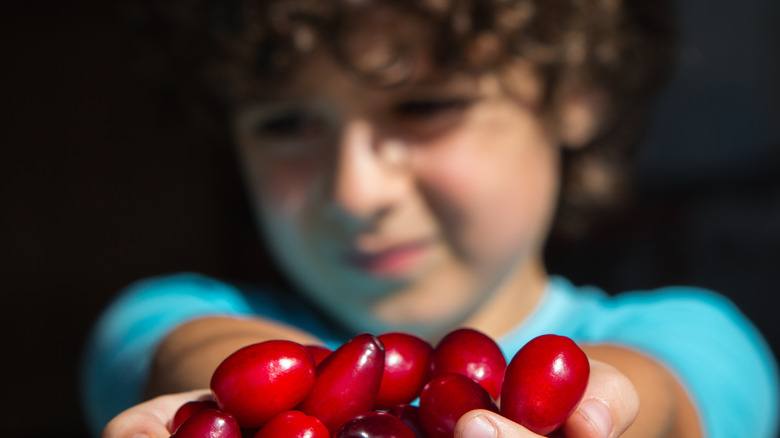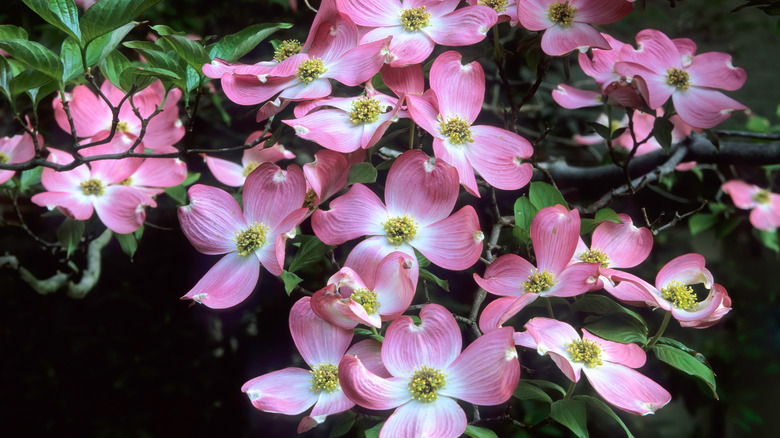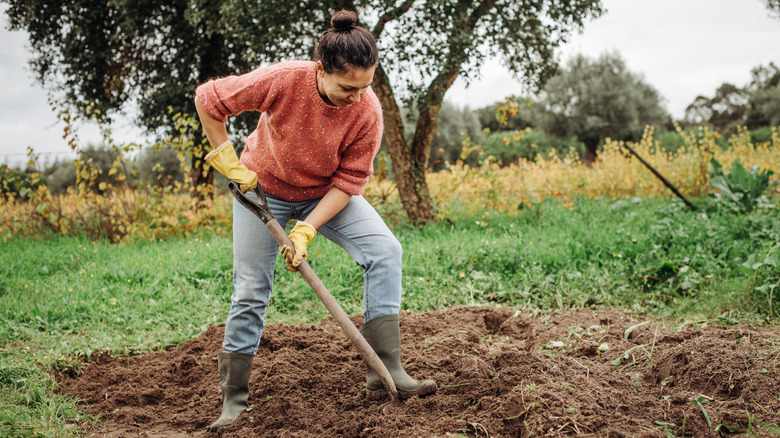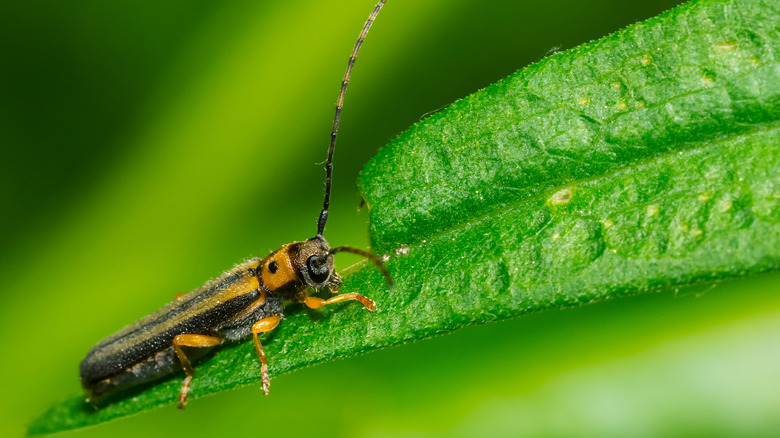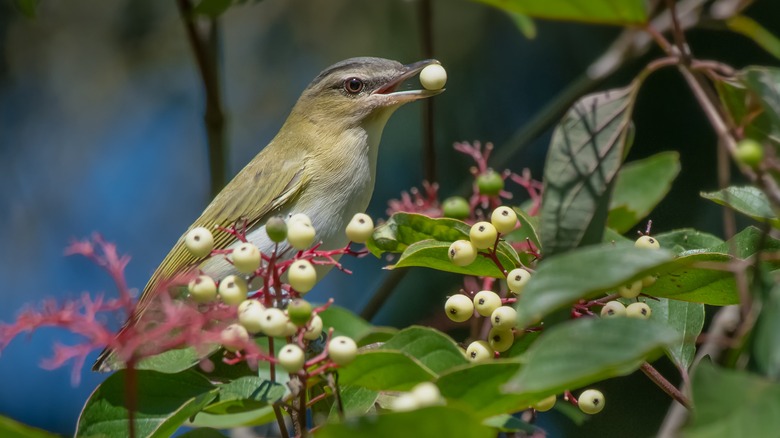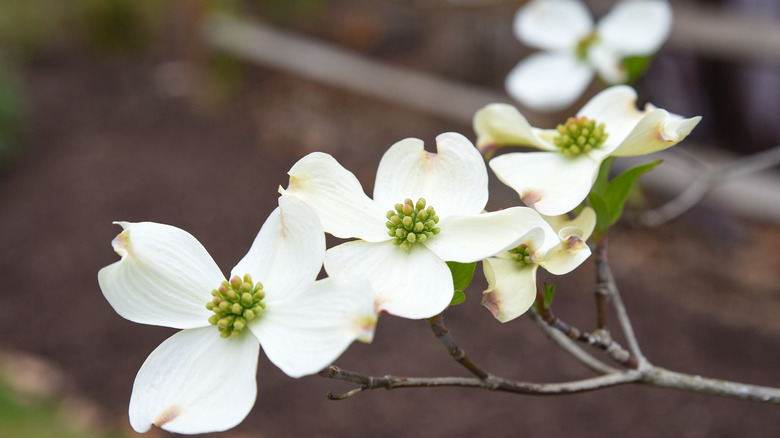How To Grow And Care For Dogwood Trees
Picture a backyard ringed with leafy, green trees. In a corner of the yard are a few azaleas and other low bushes, but standing in their midst is a small ornamental tree, its white flowers glowing in the late afternoon sun after a spring rain. That showstopper is a flowering dogwood tree (Cornus florida).
Perhaps when you think of dogwood trees, it's the posh pink ones that anchor a planting bed in a front yard, showing off for the neighbors when it blooms in spring. Or, maybe the red twig dogwood shrub is the one that comes to mind. No matter the type, there probably isn't a spot in your yard where a dogwood wouldn't look beautiful. With about five dozen species of the genus Cornus, there is a dogwood for any landscape, per MasterClass. House Digest includes the flowering dogwood at the top of its list of great small trees to plant, and with good reason: Most dogwood trees, generally topping out at 20 to 25 feet in height, won't grow above the level of a typical two-story home, which means fewer leaves and berries falling into (and clogging) gutters.
Dogwood trees aren't just favorite planting choices for homeowners; birds and other species are fond of them as well. Beloved and pretty though dogwood trees are, they aren't without their challenges. Gardeners who exercise a little attention to varietal selection, location, and routine care will be rewarded for their extra effort.
How to use dogwood trees in garden
Dogwoods are a star when used to anchor planting beds. Their size prevents them from overpowering other plants, and there are several colors of blossoms, allowing them to complement or contrast with the bed's color scheme. The Bernheim Arboretum and Research Forest in Kentucky suggests growing dogwoods in groupings. The varietals that are deciduous trees are the ones we most commonly think of when we hear "dogwood," particularly the flowering dogwood (C. florida), but shrubs and ground cover plants of that genus also can provide lasting beauty to your garden.
If you see bare branches of bright red in a neighbor's yard during the winter, they could be the unforgettable limbs of a red twig dogwood (C. sericea), a stunning addition to the garden. A bush, not a tree, the red twig dogwood comes by its name honestly, showing off brilliant red branches, making for remarkable landscape additions. The leaves are variegated for additional seasonal interest.
We don't normally think of dogwoods as ground cover plants, but in a world of vincas and pachysandras, the bunchberry (C. canadensis) will turn heads. Monrovia raves about the bunchberry's versatility as it adapts to cold or wet environments, preferring shady areas with acidic soil. The plants grow no higher than a foot and keep their leaves through the winter, though they morph from dark green to bronze or crimson. Unlike their tree counterparts, bunchberry plants are content in somewhat soggy areas of the garden.
How to grow dogwood trees
According to Home Stratosphere, dogwoods find comfortable growing conditions throughout much of the world. The popular flowering dogwood (C. florida), for example, grows best in USDA zones 5 through 9, which cover a large swath of mainland United States. Additionally, Leafy Place shares that most members of Cornus are medium- to fast-growing and are happiest with filtered sunlight (partial sun, about three or four hours of direct sun daily). Dogwood trees that flower do their best in locations with a little more than partial shade and can flourish in full sun if watered regularly. Spring is usually the best time to plant dogwoods.
Dogwoods favor soil that drains well, preferring neither soggy nor parched roots. When first planted, dogwoods need to be watered regularly. After they have become established, they may need less individual attention, but note that dogwoods have shallow root systems, leaving them more susceptible to drying out. Leaf color provides answers: Pale leaves may mean the tree is dry; grayish-green leaves may signal overwatering.
Having one dogwood will make you want more; the plants are easy to love. If you're patient, you can grow dogwoods from seeds (if the birds don't beat you to them). According to Gardening Know How, seed cultivation is easy and begins by freeing the seed from the fleshy chamber of the drupe in which it's located. Garden Mentors recommends propagating from cuttings taken from newer wood and planting the cuttings where you want them to take root.
How to care for dogwood trees
Depending on the species, a dogwood may be a 25-foot-tall tree or 6-inch high ground cover. There are similarities, though, in the light requirements (partial sun works across the board), soil needs (well-draining), and maintaining consistent watering. Garden Design calls the dogwood tree an "unfussy" addition to your yard. If planting a new tree, the Garden Lovers Club suggests different methods for dogwoods that are container-grown versus those that have bare roots, but they also assert that no matter the way the root system is presented, it should go into a hole that isn't as large as the root ball to allow for a little of it to remain higher than the ground.
Full-size dogwood trees often have a wider canopy than the height of the tree, growing naturally in that shape and necessitating little pruning. It's helpful to prune red twig dogwood bushes in late winter or very early spring. Wilson Bros Gardens urges homeowners to prune them on an annual basis, tackling the oldest branches first to help keep the plant's colors bright. If a more aggressive refresh is needed, the plant can be pruned all across the stems to a height of 10 inches.
Fertilizing dogwoods depends largely on the nutrients in your soil and the competition from other garden inhabitants. The Green Pinky cautions gardeners not to overdo the fertilizer and to stay clear of the trunk, while Garden Design suggests waiting until the second year to fertilize.
Are dogwood trees toxic?
There are a surprising number of common plants that are toxic, such as lantana, lily of the valley, Chinese lanterns, and foxglove (via The Spruce). Are dogwoods on those lists? The answer depends on the variety of dogwood. Yale Nature Walk identifies the drupes (berries) of the flowering dogwood tree as being "very poisonous." They also note that Native Americans sourced the bark of dogwood trees for medicinal purposes. Other sources validate the toxicity of dogwood berries in general, but the story doesn't end there.
According to Eat the Planet, two varieties of dogwood have berries that can be eaten by people. The Cornelian cherry dogwood (C. mas) and the Kousa dogwood (C. kousa) both have edible berries, but they look very different. The Cornelian cherry has smooth oblong fruits, while the Kousa berries are bumpy. Tyrant Farms confirms that some dogwoods have toxic fruit while others can be consumed, but they caution never to eat anything unless you're confident of the identity of the plant so you can verify its safety. As for the safety of dogwoods for our furry friends, Little Happy Paw reports that there aren't any known toxic reactions in dogs, but just like a child who eats too much candy at Christmas, a dog who ingests a lot of the dogwood berries may encounter some tummy troubles.
Dogwood tree varieties
Dogwoods come in a variety of sizes to fit most budgets and yard specifications, as noted by Gardenia. Cornus is a bit of a chameleon in the plant world. From that genus derive more than 50 species, and they take a myriad of forms from small ground-huggers to perfectly-shaped trees.
The simple-leafed plant with scaly bark has multiple varieties from which to choose and can thrive in numerous USDA growing zones. Many dogwoods have smooth-edged (not serrated) leaves that present with paler green tones early in the growing season, darkening to a glossy green, then finally turning a variety of shades of red in autumn.
Among the most common, interesting, or noteworthy are:
- Flowering dogwood (C. florida) -– This is the pretty and popular tree that is the image in your head when someone mentions a dogwood.
- Japanese dogwood (C. kousa) -– This is beloved for its profusion of white blossoms.
- Pagoda or alternate-leaf dogwood (C. alternifolia) -– Its tiered horizontal branches mimic the shape of a pagoda.
- Evergreen dogwood (C. capitata) –- Hardy in USDA zones 8 and 9, the evergreen dogwood grows as wide as it does high.
- Red twig dogwood (C. sericea) -– This is a striking landscape addition, especially in snowy winter climes.
- Red osier dogwood (C. stolonifera) –- This is a dwarf variety of red twig dogwoods.
- Bunchberry (C. canadensis) – The dreamy, glossy, dark green leaves cradle white flowers in spring and red fruits in autumn.
How to repot dogwood trees
"Difficult, but not impossible," says the Clarion Ledger as an answer to the question of transplanting dogwood trees. The shallow roots of most dogwood trees make it challenging to dig out enough of the roots without excavating a large area. Additionally, Do It Yourself asserts that a deep, thorough watering of the tree should precede any digging, targeted for late fall or the tail end of winter. The most daunting part may be the need for at least five people to move a large dogwood. You can increase the success of the transplanted dogwood by paying careful attention to the light in the new location and the preparation of the planting site.
For transplants that originate near an existing dogwood, gardeners may have more triumphs for far less work. Thrifty Fun describes the suckers that grow from a mature dogwood tree's roots. The fact that dogwoods have shallow roots can work in your favor since it is easier to get to the suckers (small trees sprouting underneath the parent tree). The "baby trees" that are cut from a root can then be moved to their chosen location where potting soil and water await them.
The Hidden Pantry is a fan of transplanting "volunteer" trees –- ones that grow in the wild of some backyards. They note that the trees that are most likely to take hold are those that are young and small with very early spring as the ideal transplanting time.
Protecting dogwood trees
Like any garden plant, your dogwood tree may be susceptible to dangers that bring about an early demise. Bower and Branch highlight three menaces: the anthracnose fungus, the dogwood borer (which sneaks in through even a small scrape on the trunk), and powdery mildew.
Penn State Extension offers a few other problems that could be lurking, including blight and crown cankers, but on a brighter note, they offer detailed solutions to prevent or fix the problems that plague your dogwood. They note that in the case of crown cankers, for example, the tree has to be removed and nothing else woody should be placed in that location until after the soil has been treated (Penn State Extension suggests the area be "fumigated and aerated" for best results). With the beauty dogwoods add to a landscape, it's a bitter pill to swallow to take down a tree, but in the long run, it could save other plants.
HGTV cites the use of a particular fungus that is beneficial to dogwood trees. Mycorrhizal fungi occur naturally in soil around dogwoods growing in the wild. HGTV recommends scooping up some of the dirt and adding it to the soil at your home to give your dogwood a boost of beneficial fungus. If you prefer not to root around under wild trees, some garden centers may carry the fungus. (Beware: Other fungi, like the anthracnose fungus can kill your tree. Know what you're adding before amending your soil.)
Dogwood trees and wildlife
If you like having birds visiting your yard, the dogwood tree is ready to help, per Birds & Blooms. The fruit (called drupes) of dogwoods provide a food source in the winter, and some butterflies seek out dogwoods for their use as well. Silk moths and bees enjoy the versatile dogwood trees, too.
The Georgia Department of Natural Resources says that dogwood trees are "underappreciated" for the job they do in attracting wildlife. Rattling off a list of birds that enjoy the nutritious berries, they add that squirrels, chipmunks, and rabbits are fans of the dogwood fruits, too, and eagerly seek them.
You might be wondering if those berries beloved by birds and bunnies are safe for humans and pets like cats and dogs. The Spruce describes the fruits of some dogwoods as bitter and sour, but more importantly, there are some that are safe to eat and others that are not. Most aren't sweet enough to eat by the handful, but they won't kill you. Check with your state extension office to find out if the tree you planted is safe to eat.
Legends and dogwood trees
Ornamental trees, like the dogwood cultivars, find their way into landscapes because they are versatile and showy. The pretty trees survive up to 80 years, offering year-round interest and a haven for birds and small animals.
In addition to the way they beautify a yard, many gardeners appreciate the history and stories that their plants tell. The dogwood tree is associated with a legend that describes the tree as having been of towering height with sturdy limbs thousands of years ago, making it the preferred wood used in crucifixions. History's most famous crucifixion was that of Jesus Christ. Believers say that Jesus altered the tree from the way it used to grow, making it grow smaller with branches that weren't straight and strong, rendering it forever unable to be used for such a brutal method of punishment. Bower and Branch notes that from that point on, as the legend recounts, the dogwood ceased to be used for such purposes.
Whether for the legend the dogwoods tell or their stunning appeal in your landscape plan, when properly selected, planted thoughtfully, spoiled a little, and lovingly cared for, your dogwoods –- tree, shrub, or ground cover -– can provide a multitude of benefits and years of enjoyment.
